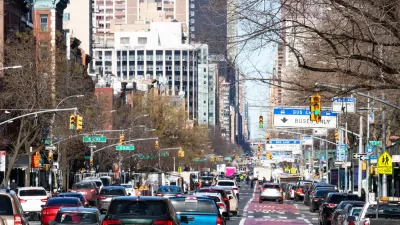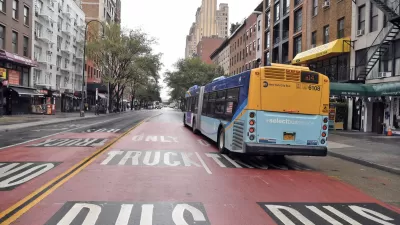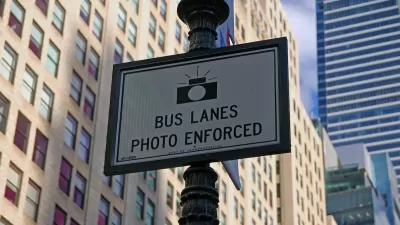Sharing lanes with car traffic may make it impossible for the MTA to increase service frequency.

Bus frequency in New York City is hindered by congestion, writes Dave Colon in Streetsblog NYC, making it practically impossible for the Metropolitan Transportation Authority (MTA) to meet a goal of improving frequency by 20 percent.
Buses will never beat a subway in terms of the total number of people one bus can move compared to a full subway train. But that doesn't mean buses need to provide significantly less bang for their buck, which is what happens when they're caught in a sea of double parked cars and trucks parked in the bus lane.
One potential solution is ramping up the use of automated enforcement to cite drivers who block bus lanes. “ABLE [Automated Bus Lane Enforcement] cameras have improved bus speeds by 5 percent on routes where they're used, and faster buses are of course one way to get more bus service for less money, as the Citizens Budget Commission pointed out in a policy brief on MTA finances in the dark days of 2021.” Yet New York’s buses are moving at the same speed now as in 2018—7.5 miles per hour.
Redesigning inefficient bus routes could also help speed up service. “City bus stops are notoriously close together compared to international peers, which means buses are constantly stopping and starting. The buses also run on long and circuitous routes that haven't been updated in decades, forcing drivers to navigate tight streets and wait out traffic to make left turns.”
Meanwhile, “A spokesperson for the MTA did not dispute the tenor of the budget negotiations, but focused on the fact that the transit system survived at all.”
FULL STORY: City Traffic Helps Make Bus Service Unbearable, Expensive And Difficult To Improve

Study: Maui’s Plan to Convert Vacation Rentals to Long-Term Housing Could Cause Nearly $1 Billion Economic Loss
The plan would reduce visitor accommodation by 25,% resulting in 1,900 jobs lost.

Alabama: Trump Terminates Settlements for Black Communities Harmed By Raw Sewage
Trump deemed the landmark civil rights agreement “illegal DEI and environmental justice policy.”

North Texas Transit Leaders Tout Benefits of TOD for Growing Region
At a summit focused on transit-oriented development, policymakers discussed how North Texas’ expanded light rail system can serve as a tool for economic growth.

Paris Bike Boom Leads to Steep Drop in Air Pollution
The French city’s air quality has improved dramatically in the past 20 years, coinciding with a growth in cycling.

Why Housing Costs More to Build in California Than in Texas
Hard costs like labor and materials combined with ‘soft’ costs such as permitting make building in the San Francisco Bay Area almost three times as costly as in Texas cities.

San Diego County Sees a Rise in Urban Coyotes
San Diego County experiences a rise in urban coyotes, as sightings become prevalent throughout its urban neighbourhoods and surrounding areas.
Urban Design for Planners 1: Software Tools
This six-course series explores essential urban design concepts using open source software and equips planners with the tools they need to participate fully in the urban design process.
Planning for Universal Design
Learn the tools for implementing Universal Design in planning regulations.
Smith Gee Studio
Alamo Area Metropolitan Planning Organization
City of Santa Clarita
Institute for Housing and Urban Development Studies (IHS)
City of Grandview
Harvard GSD Executive Education
Toledo-Lucas County Plan Commissions
Salt Lake City
NYU Wagner Graduate School of Public Service





























